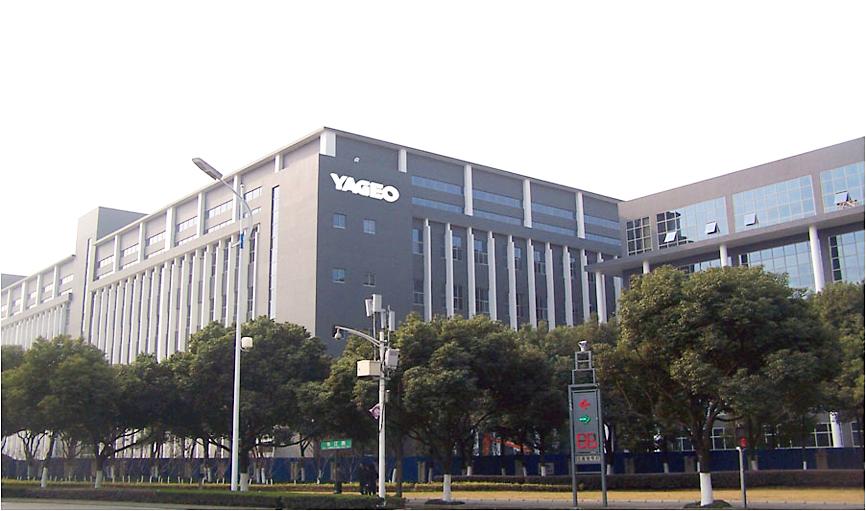Yageo Corp (國巨), which makes passive components, on Tuesday reported that net profit for last quarter increased 80 percent from a year earlier and 10.1 percent from the previous quarter to NT$3.63 billion (US$125.91 million).
Earnings per share (EPS) were NT$7.37, the highest in the past seven quarters, the company said in a statement.
The strong earnings came after Yageo, the world’s No. 3 multilayer ceramic capacitor (MLCC) supplier, posted a revenue rise of 112.8 percent annually to NT$21.95 billion, the highest in eight quarters, while gross margin rose 6.4 percentage points to 37.4 percent and operating margin moved up 8.9 percentage points to 25.1 percent.

Photo: Chang Hui-wen, Taipei Times
Yageo attributed the strong third-quarter results to synergy with US-based Kemet Corp, a US$1.64 billion acquisition, as well as a gradual improvement in production and capacity utilization, and stable demand from end customers.
However, non-operating items posted a net loss of NT$675 million, including foreign exchange losses of NT$609 million due to the appreciation of the New Taiwan dollar against the US dollar.
The foreign exchange losses cut its earnings by NT$1.24 per share last quarter, hinting that it could make more money if there were no NT dollar appreciation, the company said.
In the first three quarters of this year, net profit expanded 55.5 percent year-on-year to NT$9.27 billion, or EPS of NT$20.03, while cumulative revenue grew 45.2 percent to NT$45.45 billion, the company said.
Gross margin and operating margin improved to 40.1 percent and 27.3 percent respectively, it said.
Yageo said that it remains confident it would achieve stable revenue and profitability growth.
“The multiple demands for customized high-end specialty products in coping with future technologies will eventually maximize the company’s value in high-end automotive, industrial, medical, aerospace, 5G and Internet of Things segments,” it said.
As the global COVID-19 pandemic has not eased and the uncertainty of international trade disputes remains high, Yageo has gradually increased capacity utilization for MLCCs and chip resistors, while running at full capacity for tantalum capacitors in a bid to meet steadily increasing market demand, it said.
A sales breakdown showed that MLCCs accounted for 27 percent of the company’s sales last quarter, followed by tantalum capacitors (24 percent) and chip resistors (17 percent), JPMorgan Securities Ltd said in a note on Tuesday.
Yageo’s revenue for this quarter is forecast to decline by less than 5 percent from last quarter thanks to seasonal demand, JPMorgan said, adding that tantalum capacitors would continue to drive the company’s sales momentum.
“Tantalum capacitors are seeing surging demand from the rollout of new generations of products by the graphics processing unit [GPU] vendors, plus the launch of new game consoles,” JPMorgan said.
“These new GPUs and game console processors utilize a lot more tantalum capacitors than the previous generations,” it said. “We expect the tantalum utilization rate to remain at a very high level in the fourth quarter.”

TECH BOOST: New TSMC wafer fabs in Arizona are to dramatically improve US advanced chip production, a report by market research firm TrendForce said With Taiwan Semiconductor Manufacturing Co (TSMC, 台積電) pouring large funds into Arizona, the US is expected to see an improvement in its status to become the second-largest maker of advanced semiconductors in 2027, Taipei-based market researcher TrendForce Corp (集邦科技) said in a report last week. TrendForce estimates the US would account for a 21 percent share in the global advanced integrated circuit (IC) production market by 2027, sharply up from the current 9 percent, as TSMC is investing US$65 billion to build three wafer fabs in Arizona, the report said. TrendForce defined the advanced chipmaking processes as the 7-nanometer process or more

China’s Huawei Technologies Co (華為) plans to start mass-producing its most advanced artificial intelligence (AI) chip in the first quarter of next year, even as it struggles to make enough chips due to US restrictions, two people familiar with the matter said. The telecoms conglomerate has sent samples of the Ascend 910C — its newest chip, meant to rival those made by US chipmaker Nvidia Corp — to some technology firms and started taking orders, the sources told Reuters. The 910C is being made by top Chinese contract chipmaker Semiconductor Manufacturing International Corp (SMIC, 中芯) on its N+2 process, but a lack

NVIDIA PLATFORM: Hon Hai’s Mexican facility is to begin production early next year and a Taiwan site is to enter production next month, Nvidia wrote on its blog Hon Hai Precision Industry Co (鴻海精密), the world’s biggest electronics manufacturer, yesterday said it is expanding production capacity of artificial intelligence (AI) servers based on Nvidia Corp’s Blackwell chips in Taiwan, the US and Mexico to cope with rising demand. Hon Hai’s new AI-enabled factories are to use Nvidia’s Omnivores platform to create 3D digital twins to plan and simulate automated production lines at a factory in Hsinchu, the company said in a statement. Nvidia’s Omnivores platform is for developing industrial AI simulation applications and helps bring facilities online faster. Hon Hai’s Mexican facility is to begin production early next year and the

Who would not want a social media audience that grows without new content? During the three years she paused production of her short do-it-yourself (DIY) farmer’s lifestyle videos, Chinese vlogger Li Ziqi (李子柒), 34, has seen her YouTube subscribers increase to 20.2 million from about 14 million. While YouTube is banned in China, her fan base there — although not the size of YouTube’s MrBeast, who has 330 million subscribers — is close to 100 million across the country’s social media platforms Douyin (抖音), Sina Weibo (新浪微博) and Xiaohongshu (小紅書). When Li finally released new videos last week — ending what has